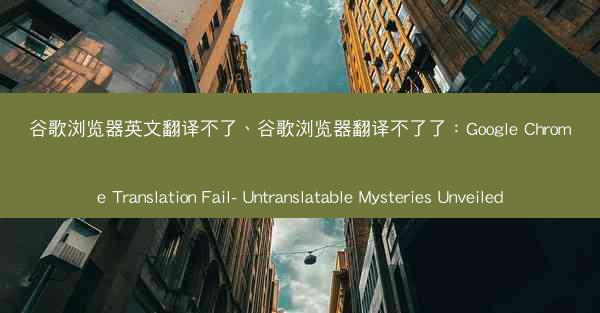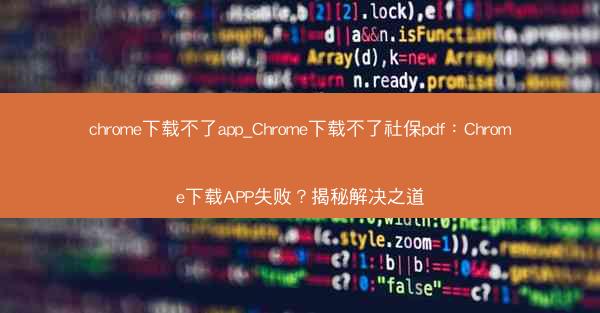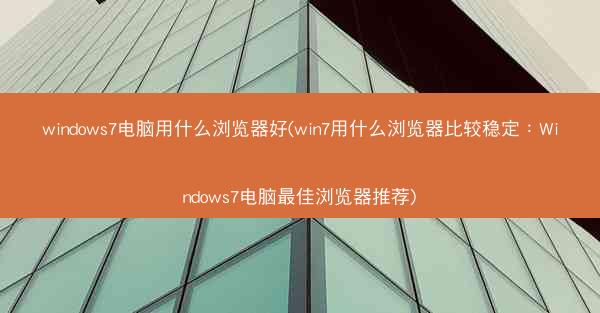谷歌浏览器英文翻译不了、谷歌浏览器翻译不了了:Google Chrome Translation Fail- Untranslatable Mysteries Unveiled
 telegram中文版
telegram中文版
硬件:Windows系统 版本:11.1.1.22 大小:9.75MB 语言:简体中文 评分: 发布:2020-02-05 更新:2024-11-08 厂商:telegram中文版
 telegram安卓版
telegram安卓版
硬件:安卓系统 版本:122.0.3.464 大小:187.94MB 厂商:telegram 发布:2022-03-29 更新:2024-10-30
 telegram ios苹果版
telegram ios苹果版
硬件:苹果系统 版本:130.0.6723.37 大小:207.1 MB 厂商:Google LLC 发布:2020-04-03 更新:2024-06-12
跳转至官网

The article delves into the issue of Google Chrome's translation failure, commonly referred to as Google Chrome Translation Fail- Untranslatable Mysteries Unveiled. It explores the reasons behind the failure of Google Chrome to translate certain texts, the impact it has on users, and the potential solutions that can be implemented to improve the translation accuracy.
---
Introduction to Google Chrome Translation Failure
Google Chrome, one of the most popular web browsers, offers a convenient translation feature that allows users to translate web pages from one language to another. However, there are instances where the translation fails, leaving users frustrated with the Google Chrome Translation Fail- Untranslatable Mysteries Unveiled. This article aims to uncover the mysteries behind these translation failures and provide insights into the reasons and potential solutions.
1. Limitations of Machine Translation
Machine translation, which powers Google Chrome's translation feature, has its limitations. Here are a few reasons why Google Chrome might fail to translate certain texts:
- Complex Language Structures: Machine translation struggles with languages that have complex grammatical structures and idiomatic expressions. For example, languages like Chinese, Japanese, and Arabic often pose challenges due to their unique writing systems and grammatical rules.
- Contextual Understanding: Machine translation relies on algorithms to interpret text, but it may lack the ability to understand the context in which a word or phrase is used. This can lead to inaccuracies or misinterpretations.
- Technical Limitations: The translation algorithms are not perfect and can sometimes produce nonsensical or grammatically incorrect translations.
2. User-Generated Content
The translation failure can also be attributed to the nature of user-generated content on the internet. Here are some factors to consider:
- Spelling and Grammatical Errors: User-generated content often contains spelling and grammatical errors, which can be difficult for machine translation to handle accurately.
- Jargon and Slang: Certain industries or communities use specialized jargon and slang, which may not be recognized by the translation algorithms.
- Cultural Nuances: The translation of culturally specific content can be challenging, as certain phrases or expressions may not have direct equivalents in other languages.
3. Language Pair Compatibility
The compatibility between the source and target languages can also affect the translation process:
- Rare Language Pairs: Some language pairs are less commonly translated, and the available resources for these pairs may be limited, leading to less accurate translations.
- Language Evolution: Languages evolve over time, and machine translation systems may not always keep up with the latest changes in vocabulary and usage.
- Language Specificities: Certain languages have unique features that are difficult to translate, such as gender-specific words or honorifics.
4. User Interface Issues
The user interface of Google Chrome's translation feature can sometimes contribute to translation failures:
- Incorrect Language Detection: The browser may incorrectly detect the language of the text, leading to an incorrect translation.
- Limited Translation Options: Users may not have access to all the translation options available, which can limit the accuracy of the translation.
- User Error: Users may inadvertently use the translation feature incorrectly, such as translating the wrong part of the text or not selecting the correct language pair.
5. Technical Glitches and Updates
Technical issues within the browser or updates to the translation algorithms can also cause translation failures:
- Software Bugs: Occasionally, software bugs can cause the translation feature to malfunction, leading to incorrect translations.
- Algorithm Updates: When the translation algorithms are updated, there can be a period of adjustment where the translations may be less accurate.
- Resource Allocation: The browser may not be allocating sufficient resources to the translation feature, leading to slower and less accurate translations.
6. Potential Solutions and Improvements
To address the issue of Google Chrome's translation failure, several solutions and improvements can be considered:
- Enhanced Algorithmic Capabilities: Investing in more advanced translation algorithms that can better handle complex language structures and contextual understanding.
- User Education: Providing users with guidance on how to use the translation feature effectively and how to interpret the translations.
- Continuous Improvement: Regularly updating the translation algorithms and user interface to improve the accuracy and usability of the translation feature.
---
Conclusion
The Google Chrome Translation Fail- Untranslatable Mysteries Unveiled highlights the challenges and limitations of machine translation in Google Chrome. By understanding the reasons behind these translation failures, users can better navigate the feature and developers can work towards improving its accuracy and reliability. While machine translation will always have its limitations, ongoing efforts to refine the algorithms and user interface can help bridge the gap between the intended and actual translations.












